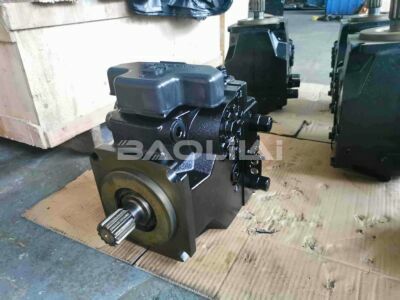Methods and precautions for judging the decrease in volumetric efficiency of plunger pumps
Volumetric efficiency is a measure of a pump's ability to move fluid compared to its theoretical maximum capacity. For piston pumps (which are positive displacement pumps), volumetric efficiency is critical in evaluating their performance. The following are some general steps and considerations for determining a decrease in volumetric efficiency of a plunger pump:
1. Flow measurement:
Measure the actual flow rate of the pump. This can be done by collecting the fluid discharged by the pump over a known time and calculating the flow rate. Compare this value to the theoretical flow rate the pump should achieve based on its design specifications.
2. Pressure measurement:
Measure the pump discharge pressure. Compare this value to the expected pressure based on the pump design. A decrease in pressure may indicate a decrease in volumetric efficiency.
3. Compare to manufacturer specifications:
Refer to the plunger pump manufacturer's specifications and performance curves. Compare actual performance (flow and pressure) with values provided by the manufacturer. Any significant deviation may indicate a decrease in volumetric efficiency.
4. Check for leaks:
Check the pump and its associated piping for leaks. Leakage can significantly reduce the volumetric efficiency of the pump. Look for visible leaks and listen for any unusual sounds that might indicate a leak.
H1-P-078-L-A-A-A5-C2-N-D6-H-G1-H3-L-38-L-38-C-L-24-PN-NNN-NNN H1P078LAAA5C2ND6HG1H3L38L38CL24PNNNNNNN
H1-P-078-L-A-A-A5-C2-N-D6-H-G1-H3-L-35-L-35-F-L-24-PN-NNN-NNN H1P078LAAA5C2ND6HG1H3L35L35FL24PNNNNNNN
H1-P-078-L-A-A-A5-C2-N-D6-H-G1-H2-L-42-L-42-C-L-24-PN-NNN-NNN H1P078LAAA5C2ND6HG1H2L42L42CL24PNNNNNNN
H1-P-078-L-A-A-A5-C2-N-D6-H-G1-H2-L-35-L-35-C-L-24-PN-NNN-NNN H1P078LAAA5C2ND6HG1H2L35L35CL24PNNNNNNN
H1-P-078-L-A-A-A5-C2-N-D6-H-G1-H2-L-30-L-30-C-L-24-PN-NNN-NNN H1P078LAAA5C2ND6HG1H2L30L30CL24PNNNNNNN
H1-P-078-L-A-A-A5-C2-N-D3-H-G9-NN-L-40-L-40-C-M-24-PN-NNN-NNN H1P078LAAA5C2ND3HG9NNL40L40CM24PNNNNNNN
H1-P-078-L-A-A-A5-C2-N-D3-H-G9-H3-L-42-L-42-C-M-24-PN-NNN-NNN H1P078LAAA5C2ND3HG9H3L42L42CM24PNNNNNNN
H1-P-078-L-A-A-A5-C2-N-D3-H-G1-NN-L-35-L-35-C-N-20-PN-NNN-NNN H1P078LAAA5C2ND3HG1NNL35L35CN20PNNNNNNN
H1-P-078-L-A-A-A5-C2-N-D3-H-G1-NN-L-35-L-35-C-M-24-PN-NNN-NNN H1P078LAAA5C2ND3HG1NNL35L35CM24PNNNNNNN
H1-P-078-L-A-A-A5-C2-N-D3-H-G1-H3-L-38-L-38-F-M-24-PN-NNN-NNN H1P078LAAA5C2ND3HG1H3L38L38FM24PNNNNNNN
H1-P-078-L-A-A-A5-C2-N-D3-H-G1-H2-L-25-L-25-F-M-24-PN-NNN-NNN H1P078LAAA5C2ND3HG1H2L25L25FM24PNNNNNNN
H1-P-078-L-A-A-A5-C2-B-F6-H-G9-H6-L-28-L-28-C-L-24-PN-NNN-NNN H1P078LAAA5C2BF6HG9H6L28L28CL24PNNNNNNN
H1-P-078-L-A-A-A5-C2-B-F5-H-G1-H6-K-25-K-25-C-P-24-PN-NNN-NNN H1P078LAAA5C2BF5HG1H6K25K25CP24PNNNNNNN
H1-P-078-L-A-A-A5-C2-B-D8-H-G1-NN-L-35-L-35-C-P-24-PN-NNN-NNN H1P078LAAA5C2BD8HG1NNL35L35CP24PNNNNNNN
H1-P-078-L-A-A-A5-C2-B-D8-H-G1-NN-L-30-L-30-C-P-24-PN-NNN-NNN H1P078LAAA5C2BD8HG1NNL30L30CP24PNNNNNNN
H1-P-078-L-A-A-A5-C2-B-D8-H-G1-NN-K-35-K-35-C-P-24-PN-NNN-NNN H1P078LAAA5C2BD8HG1NNK35K35CP24PNNNNNNN
H1-P-078-L-A-A-A5-C2-B-D8-H-G1-H3-L-35-L-35-N-E-24-PN-NNN-NNN H1P078LAAA5C2BD8HG1H3L35L35NE24PNNNNNNN
H1-P-078-L-A-A-A5-C2-B-D8-H-G1-H3-L-35-L-35-C-P-24-PN-NNN-NNN H1P078LAAA5C2BD8HG1H3L35L35CP24PNNNNNNN
H1-P-078-L-A-A-A5-C2-B-D8-H-G1-H3-L-28-L-28-N-E-24-PN-NNN-NNN H1P078LAAA5C2BD8HG1H3L28L28NE24PNNNNNNN
H1-P-078-L-A-A-A5-C2-B-D8-H-G1-H3-K-25-K-25-C-P-24-PN-NNN-NNN H1P078LAAA5C2BD8HG1H3K25K25CP24PNNNNNNN
5. Check valves and seals:
Check the condition of valves and seals in the pump. Worn or damaged valves and seals can cause internal leaks and reduce volumetric efficiency. Make sure these parts are in good condition and replace any that show signs of wear.
6. Check the plunger and cylinder:
Check the plunger and cylinder for signs of wear or damage. Any irregularities in these components will affect the pump's ability to efficiently displace fluid. Replace or repair damaged parts as necessary.
7. Fluid characteristics:
Changes in fluid properties, such as viscosity, can affect plunger pump performance. Make sure the fluid being pumped is within the pump's specified range. Adjustments may be required if the characteristics of the pumped fluid change.
8. Operating conditions:
Consider the operating conditions of the pump, including speed, temperature, and suction conditions. Changes in these factors can affect volumetric efficiency. Make sure the pump is operating within recommended parameters.
9. Regular maintenance:
Carry out a regular maintenance schedule for your plunger pump. Routine maintenance, including lubrication, bolt tightening and cleaning, helps prevent problems that could lead to reduced volumetric efficiency.
10. Consult the experts:
If a decrease in volumetric efficiency cannot be easily identified and resolved, consider consulting an expert or the pump manufacturer. They can provide specific insights and guidance based on pump design and application.

Regular monitoring, maintenance and troubleshooting are critical to ensuring continued efficient operation of your plunger pump.
11.Performance test:
Performance testing under controlled conditions. This may involve running the pump at different speeds and loads to observe its behavior. The data collected during these tests are analyzed to identify any patterns or anomalies that may indicate a decrease in volumetric efficiency.
12. Check for cavitation:
Cavitation can negatively affect plunger pump performance. Check the pump for signs of cavitation, such as pits on the plunger or cylinder surface. Address the root cause of cavitation, which may be related to suction conditions or impurities in the fluid.
13. Review system design:
Evaluate overall system design, including layout of piping, valves, and other components. Poor system design can cause pressure drops and affect volumetric efficiency. Consider consulting with a hydraulic systems engineer to optimize system layout.
14. Utilize diagnostic tools:
Utilize diagnostic tools and techniques such as vibration analysis, temperature monitoring, or condition monitoring systems. These tools provide insight into pump health and help detect issues affecting volumetric efficiency.
15. Check the suction side:
Check the suction side of the pump system for any restrictions or problems. Insufficient suction conditions lead to reduced volumetric efficiency. Make sure the pump is fully primed and the suction line is not clogged.
H1-P-078-L-A-A-A5-C2-B-D8-H-F1-H3-L-35-L-35-F-P-24-PN-NNN-NNN H1P078LAAA5C2BD8HF1H3L35L35FP24PNNNNNNN
H1-P-078-L-A-A-A5-C2-B-D6-H-G9-NN-L-35-L-35-C-L-20-PN-NNN-NNN H1P078LAAA5C2BD6HG9NNL35L35CL20PNNNNNNN
H1-P-078-L-A-A-A5-C2-B-D6-H-G9-NN-K-40-K-40-F-L-24-PN-NNN-NNN H1P078LAAA5C2BD6HG9NNK40K40FL24PNNNNNNN
H1-P-078-L-A-A-A5-C2-B-D6-H-G9-H2-L-28-L-28-C-L-24-PN-NNN-NNN H1P078LAAA5C2BD6HG9H2L28L28CL24PNNNNNNN
H1-P-078-L-A-A-A5-C2-B-D6-H-G1-NN-L-35-L-35-C-L-24-PN-NNN-NNN H1P078LAAA5C2BD6HG1NNL35L35CL24PNNNNNNN
H1-P-078-L-A-A-A5-C2-B-D6-H-G1-H2-L-28-L-28-C-L-24-PN-NNN-NNN H1P078LAAA5C2BD6HG1H2L28L28CL24PNNNNNNN
H1-P-078-L-A-A-A5-C2-B-D3-H-G9-H3-L-28-L-28-C-M-20-PN-NNN-NNN H1P078LAAA5C2BD3HG9H3L28L28CM20PNNNNNNN
H1-P-078-L-A-A-A5-C2-B-D3-H-G9-H3-L-20-L-20-C-M-20-PN-NNN-NNN H1P078LAAA5C2BD3HG9H3L20L20CM20PNNNNNNN
H1-P-078-L-A-A-A5-C2-B-D3-H-G9-H2-L-35-L-35-C-M-24-PN-NNN-NNN H1P078LAAA5C2BD3HG9H2L35L35CM24PNNNNNNN
H1-P-078-L-A-A-A5-C2-B-D3-H-F1-H5-L-23-L-23-C-M-22-PN-NNN-NNN H1P078LAAA5C2BD3HF1H5L23L23CM22PNNNNNNN
H1-P-078-L-A-A-A5-C1-N-D8-H-G1-NN-L-20-L-20-N-E-24-PN-NNN-NNN H1P078LAAA5C1ND8HG1NNL20L20NE24PNNNNNNN
H1-P-078-L-A-A-A5-C1-N-D6-H-G1-H3-L-35-L-35-F-L-24-PN-NNN-NNN H1P078LAAA5C1ND6HG1H3L35L35FL24PNNNNNNN
H1-P-078-L-A-A-A5-C1-N-D6-H-F1-H2-L-35-L-35-C-L-20-PN-NNN-NNN H1P078LAAA5C1ND6HF1H2L35L35CL20PNNNNNNN
H1-P-078-L-A-A-A5-C1-B-F6-H-F1-H6-L-45-L-45-C-L-24-PN-NNN-NNN H1P078LAAA5C1BF6HF1H6L45L45CL24PNNNNNNN
H1-P-078-L-A-A-A5-C1-B-D6-H-G1-NN-L-45-L-45-C-L-24-PN-NNN-NNN H1P078LAAA5C1BD6HG1NNL45L45CL24PNNNNNNN
H1-P-078-L-A-A-A5-C1-B-D6-H-F1-H3-L-33-L-33-F-L-24-PN-NNN-NNN H1P078LAAA5C1BD6HF1H3L33L33FL24PNNNNNNN
H1-P-078-L-A-A-A5-C1-B-D6-H-F1-H2-L-42-L-42-C-L-20-PN-NNN-NNN H1P078LAAA5C1BD6HF1H2L42L42CL20PNNNNNNN
H1-P-078-L-A-A-A5-C1-B-D3-H-G9-S1-L-33-L-33-C-M-24-PN-NNN-NNN H1P078LAAA5C1BD3HG9S1L33L33CM24PNNNNNNN
H1-P-078-L-A-A-A5-C1-B-D3-H-G9-H5-L-33-L-33-C-M-24-PN-NNN-NNN H1P078LAAA5C1BD3HG9H5L33L33CM24PNNNNNNN
H1-P-078-L-A-A-A4-C3-N-D6-H-G1-H2-L-35-L-35-C-L-20-PN-NNN-NNN H1P078LAAA4C3ND6HG1H2L35L35CL20PNNNNNNN
16. Document changes over time:
Keep detailed records of pump performance over time. Document any changes in operating conditions, maintenance activities, or system modifications. This historical data is valuable for identifying trends and diagnosing problems.
17. Consider environmental factors:
Environmental conditions such as temperature and humidity can affect pump performance. Evaluate whether changes in environmental factors are associated with reduced volumetric efficiency.
18. Training and Operator Awareness:
Make sure the operator is well trained and understands the proper operating procedures for the plunger pump. Misuse or improper operation can result in reduced efficiency. Training programs and regular refresher courses can help maintain a knowledgeable and skilled operations team.
19. Seek professional help:
If troubleshooting and corrective actions do not produce satisfactory results, consider seeking help from a professional pump expert or engineer. They may perform a more in-depth analysis and provide recommendations for resolving issues affecting volumetric efficiency.
Keep in mind that addressing reduced volumetric efficiency may require a combination of measures, and a systematic approach to troubleshooting and maintenance is critical. Regular monitoring and proactive maintenance practices can help prevent and mitigate problems before they seriously impact pump performance.
This article is published by the official website of Baolilai Hydraulics, please contact the author and indicate the source for reprinting:https://www.baolilai-pump.cn/news/1166.html






